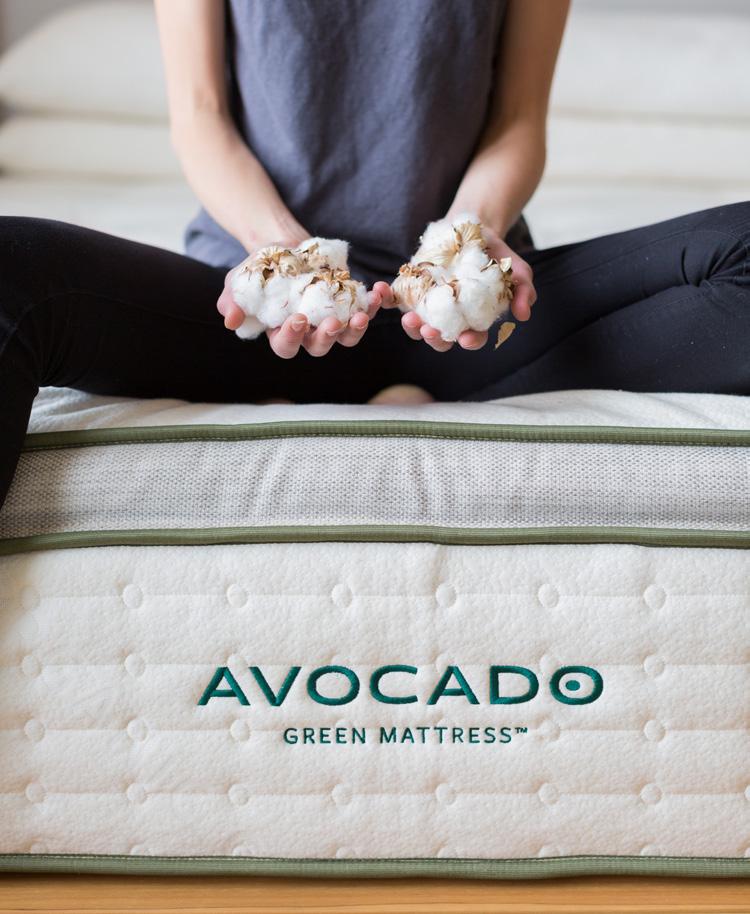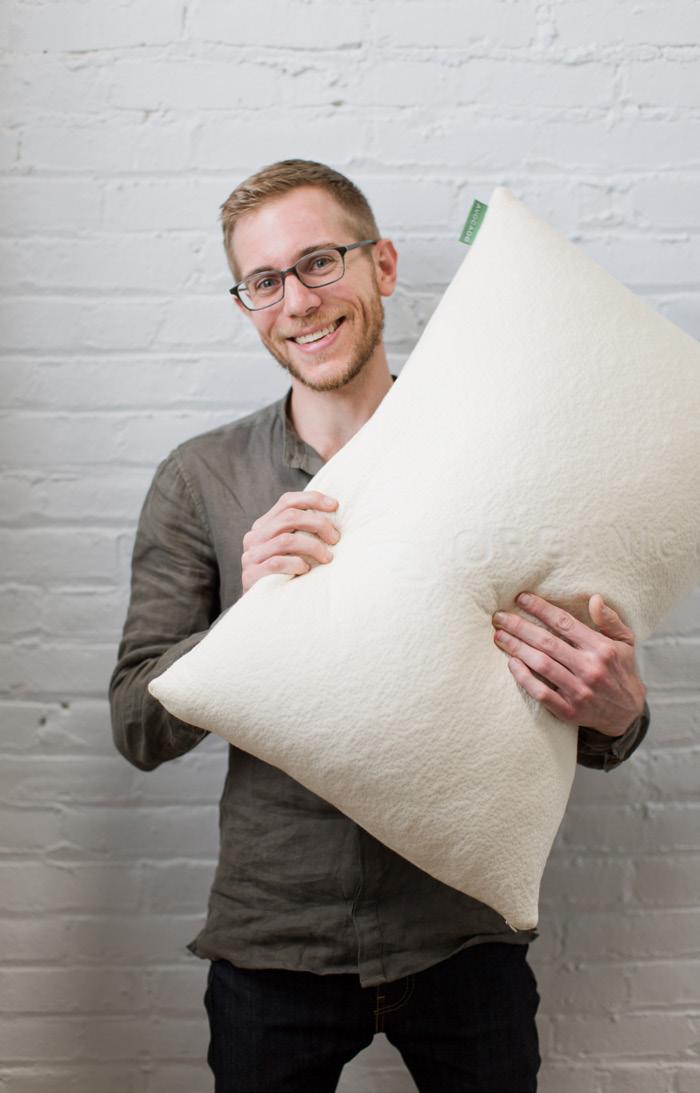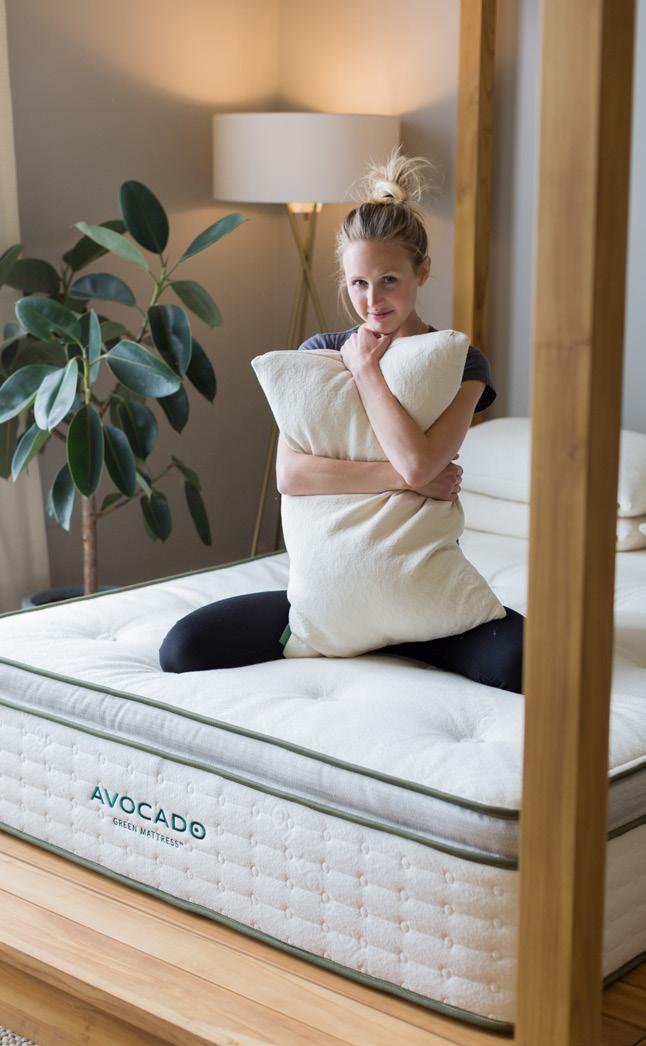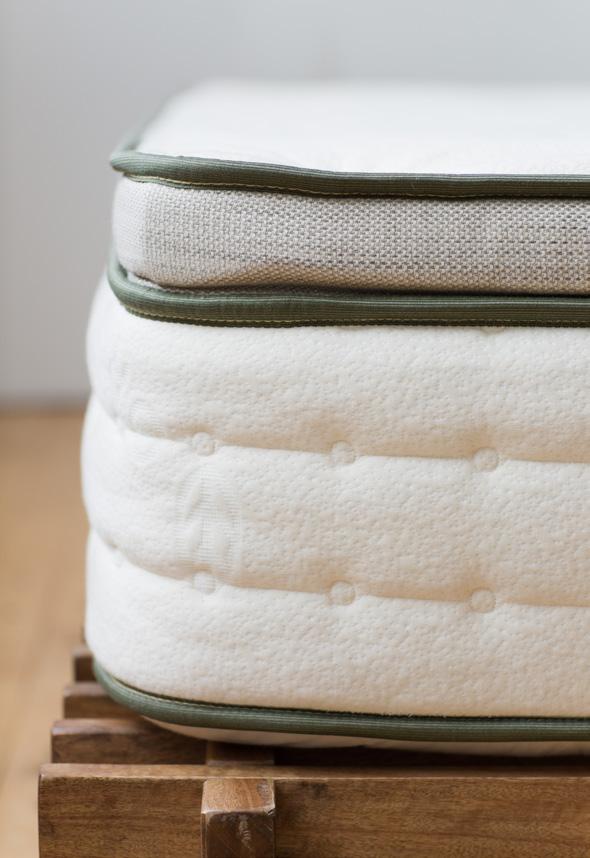
17 minute read
Avocado Green Mattress
Avocado Green Mattress: Improving Personal and Planetary Health in One Fell Snooze By Ainsley Schoppel Photography: Avocado Green Mattress
Sleep. Babies do it intermittently, teenagers do it a lot, and the rest of us take what we can get in our busy lives. In fact, the average person sleeps for eight hours a day, which means that we all spend one third of our lives asleep.
Advertisement
Let that sink in. We spend one third of our lives sleeping in our beds.
Our mattresses are supposed to support us, comfort us, and leave us feeling restored after a night’s rest. Just like the contents of a nourishing meal, the components of our mattresses should support our health. But, on what are we sleeping exactly?

Traditional mattresses release minute amounts of gaseous chemicals known as volatile organic compounds or VOCs. These mainly emit from the polyurethane in the mattress, but they have also been found to come from chemicals used in mattress flame retardants as well as plastic components. VOCs have negative health impacts including eye, nose, and throat irritation, headaches, and even organ damage. On the extreme end, some VOCs such as formaldehyde and acetaldehyde have been associated with an increased risk of cancer.
This all sounds more than a little worrisome, but rest easy knowing Avocado Green Mattress has a comfortable solution. Jeff, one of the company’s founders, was searching for an affordable non-toxic mattress and came up empty-handed. During his thorough research, he discovered frustrating greenwashing and a disturbing lack of transparency that is still a massive problem in the industry today. Since he couldn’t find what he was looking for, he set out to make it instead. Founded in 2016 by four friends with only $40,000 in Hoboken, New Jersey, Avocado Mattress was born and became an industry-shifting idea that remains private to this day.

Last year, Avocado became the first mattress company to become Climate Neutral Certified, and this year they officially became carbon negative and a certified B Traditional mattresses release minute amounts of gaseous chemicals known as “ volatile organic compounds or VOCs. These mainly emit from the polyurethane in the mattress, but they have also been found to come from chemicals used in mattress flame retardants as well as plastic components. VOCs have negative health impacts including eye, nose, and throat irritation, headaches, and even organ damage. On the extreme end, some VOCs such as formaldehyde and acetaldehyde have been associated with an increased risk of cancer. “
Corporation. By partnering with Bonneville Environmental Foundation, Avocado pays to remove carbon from the atmosphere and prevents greenhouse gases from landing there in the first place by financing forest conservation and clean energy initiatives. Avocado Green Mattress also boasts the highest rated mattresses by Consumer Reports for 2018, 2019, and 2020, proving that they can manufacture organic and natural mattresses and sleep products while maintaining environmentally conscious, ethical, and sustainable business practices across their entire supply chain.
Demonstrating that “farm-to-table” doesn’t only apply to the food production and restaurant industries,
Avocado is also showing the world that mattresses can be manufactured in a farm-to-bedroom manner.
To start, Avocado raises 180,000 sheep that freely wander throughout 40,000 hectares that are companymanaged in the Himachal Pradesh region of northern India. This sustainably harvested wool is used in Avocado’s Green Mattresses, Luxury Crib Mattresses, Organic Crib Mattresses, and toppers. It is soft, breathable, and one of the world’s best thermoregulating natural fibers. From the fields, the wool travels to Avocado’s co-owned GOTS (Global Organic Textile Standard) organic certified wool factory along the white-water Sutlej River in Rampur. This facility is a vital enterprise

in the community and employs many women who were victims of domestic violence. Their jobs within the wool factory help to bolster their independence and provide them with a safe and reliable source of income. It’s here that the raw wool is naturally cleaned, carded, and combed, and the resulting product is some of the highest quality organic wool in the world.
In addition to wool, another key component of Avocado mattresses is latex. The best and most comfortable mattresses in the world are made with organic, 100% natural latex rubber. No other material is comparable in terms of comfort, resiliency, elasticity, breathability, motion isolating capabilities, durability and longevity, support, and even biodegradability. Latex truly provides a support layer with incomparable comfort.
Two thousand miles south of Avocado’s wool factory lies the lush and diverse region of Kochi. Avocado co-owns the Avocado Organic Latex processing facility and manages more than 4,000 acres of FSC and USDA certified organic latex farms. The FSC certification ensures that ten governing principles and fifty-seven criteria for sustainable use, conservation, restoration, and respect for all are adhered to. Within these plantations, rubber trees (Hevea Brasiliensis) can be found in rows by the thousands, and farmers harvest pure rubber
sap that will later be used to make the latex foam cores in Avocado mattresses and toppers. Once this 100% GOLS (Global Organic Latex Standard) organic latex is collected, it is then sent to Avocado’s jointly owned processing facility in Kerala. By eliminating the middlemen in this supply chain, Avocado is able to skirt costly markup scenarios and provide transparency and traceability to its customers. When the latex sap arrives at the processing facility, it is then whipped into a froth, poured

Demonstrating that “farm-to-table” doesn’t only apply to the food “ production and restaurant industries, Avocado is also showing the world that mattresses can be manufactured in a farm-tobedroom manner. To start, Avocado raises 180,000 sheep that freely wander throughout 40,000 hectares that are companymanaged in the Himachal Pradesh region of northern India. This sustainably harvested wool is used in Avocado’s Green Mattresses, Luxury Crib Mattresses, Organic Crib Mattresses, and toppers. It is soft, breathable, and one of the world’s best thermoregulating natural fibers. “
into molds, covered, and steam baked. The end result is a clean and environmentally friendly material that is durable, safe, and supportive. Although organic latex may look the same as natural, blended, or synthetic latex, it is not. Only organic latex is truly safe for farmers, for their families, for you, and for the planet.
Currently, no other mattress brands follow this approach of sourcing and processing organic, ethical, sustainable, and responsible components that are grown and harvested without persistent pesticides and herbicides.
Once the wool, latex, and organic cotton arrive at Avocado’s factory in Los Angeles, they are cut and handsewn into a selection of products before passing a stringent quality control inspection to ensure the most premium of end products. It is only then that Avocado’s mattresses and toppers are shipped to customers, completing the farm,


to factory, to home journey. It’s a journey of which Avocado is proud and one with which its customers can rest easy—and comfortably.
“Going green” has become somewhat of a ubiquitous term, loosely claimed and held aloft by companies to attract conscious consumers to their products or services. But what does it actually mean to “go green” in the world of mattresses? Why does it matter so much?
Well, the answer is unsurprisingly multidimensional.
Did you know that according to the U.S. Environmental Protection Agency, indoor air can be five times more polluted than outdoor air? Multiple studies have shown that chemically treated materials commonly used in our manufacturing and building processes negatively impact human health. Through off-gassing, abrasion, leaching, and oxidation, these materials release toxic chemicals into our home and work environments that contaminate our air, water, food supplies, and surrounding natural environment. Since we spend an average of ninety percent of our time indoors working, learning, playing, and sleeping, this should be concerning. And, since mattresses are large items that often appear in more than one room in the home, swapping traditional mattresses for organic options is an easy way to clear the air and decrease health risks.
Avocado Green Mattress contains no toxic flame retardants of any kind. That means there are no toxic chemicals, no rayon, no fiberglass fibers, and no boric acid or other hidden chemical treatments. This has earned them the Made Safe Non-Toxic certification, which makes Avocado one of only three mattress brands in the entire world to meet this safety standard. Also, the layers of an Avocado mattress are not glued together, they are tufted together by hand using long steel tufting needles, cotton straps, and rosettes. Because of this method of securing the layers, Avocado does not use any solventbased or water-based chemical adhesives. (Don’t be fooled by brands touting their water-based adhesives—they off-gas just like solvent-based adhesives!) Speaking of chemicals, Avocado does not use any polyester because it does not stretch, absorb sweat, or breathe, and it’s treated with thousands of toxic chemicals during production.

As a result of their stringent dedication to organic manufacturing, Avocado has been Greenguard Gold certified which means their products have been scientifically tested to meet the most rigorous emission standards for chemical exposure and pollutants. Few mattresses and pillows on the market today qualify for this standard.
So, Avocado mattresses are clearly the greener and healthier option in terms of sleep and general health, but can green also be comfortable? The resounding answer is, YES! Using an ergonomic innerspring support system made up of 1,414 individually wrapped springs made from recycled steel, Avocado mattresses contour to the curves of each body and provide spinal alignment and relief at all pressure-points. Proven through independent lab tests, Avocado mattresses were found to lose only one percent of their height after ten years of hard usage! Perhaps most impressively, Avocado mattresses will biodegrade at the end of their lives and the steel springs can be recycled, which means you won’t find Avocado mattresses piling up in landfills for generations to come. And, with a twenty-five-year warranty which includes the ability to return your mattress for the full replacement value plus shipping expenses within the first ten years, there is nothing holding you back from making a change and trying the green-sleeping life for yourself. (Their sleep trial lasts a full year, so if you’re not happy with your mattress within that time, Avocado will fully refund your purchase and arrange for donation or recycling of your mattress.)


If you want to ensure your entire sleep environment is healthy, safe, and beautiful, Avocado also offers pillows and protectors, mattress pads, crib pads, sheets, throws, face masks, bed frames, dressers, and end tables.
For Avocado Green Mattress, it’s about more than a healthy green sleep—it’s about a healthy green planet. After all, we may be tucked into our own beds, but we’re all sleeping under the same great night sky.
Sweet (and green) dreams!
ymore info: www.avocadogreenmattress.com IG: @avocadomattress FB: @avocadomattress
The Importance of Our Microbiome on Immune Response to Viruses Could They Actually Make Us Healthier?
The wave of fear in reaction to Covid-19 has disrupted all of our lives in so many ways, and the question we should be asking ourselves is whether or not our collective reaction to this virus is justified. To evaluate this, I’m going to discuss the facts about the microbial world of viruses, bacteria, parasites, and fungi, and
By Dr. Jim Bentz
the ways in which our microbiome can have a huge effect on the strength of our immune system and overall health.

Viruses are the smallest known biological particle (the tiniest are only twenty nanometers in diameter). However, they are not biological organisms so they are not classified in any kingdom of living things. They do not have any organelles and they cannot respire or perform metabolic functions, and they can’t reproduce on their own. This means viruses are not living organisms. So, what are they? A virus is basically a packet of information in the form of DNA or RNA—the building blocks of genes and life.
Scientists studying genes and proteins found that viruses are ancient, but they were not the first form of life. In fact, research suggests viruses and bacteria share a common ancestor: a fully functioning, self-replicating cell that lived around 3.4 billion years ago, shortly after life first emerged on the planet. From this cell, bacteria have evolved in the direction of increasing complexity, while viruses have gradually shed unneeded genes until they were no longer able to reproduce on their own.
Today, it’s tempting to think of viruses as mere pests. But, “They are not agents of destruction,” says Gustavo Caetano-Anolles of the University of Illinois. “Life on Earth would look very different without our viral co-inhabitants.” James Shapiro, a University of Chicago microbiologist notes that “we wouldn’t be here without them”. For example, researchers speculate that more than 100 million years ago a viral infection in a primitive mammal uploaded a gene that helped the placenta evolve. Syncytin is a protein that viruses use to fuse cells together in order to hop from one host cell to the next. In mammals, it fuses placenta cells with the uterus and allows the fetus to draw nutrients from its mother.
Humans co-evolved over millions of years with viruses, and current science tells us that they provide critical updates to our system in much the same way that our cell phones update on a regular basis to improve function. It’s interesting to note that when the human genetic code was mapped in 2003, researchers found that nine percent of our genetic material was from RNA or retroviruses: the same type of virus as Covid-19.
Today, it’s tempting to think of viruses as mere pests. But, “They are not “ agents of destruction,” says Gustavo CaetanoAnolles of the University of Illinois. “Life on Earth would look very different without our viral coinhabitants.” James Shapiro, a University of Chicago microbiologist notes that “we wouldn’t be here without them”. For example, researchers speculate that more than 100 million years ago a viral infection in a primitive mammal uploaded a gene that helped the placenta evolve. “

For a more in depth discussion of viruses and the ways in which they affect human biology, I recommend watching Dr. Zach Bush’s presentation on The Microbiome Movement. Dr. Bush is a triple board certified M.D., and provides deep insight as to the truth about viruses, as well as the world of microbes including bacteria, parasites, and fungi, and the ways in which they play a vital role in our health as part of our microbiome.
Our microbiome is the totality of all the viruses, bacteria, parasites, and fungi living not only in our gut, but on our skin, in our mouth, nose, sinuses, and yes, even in our brain. The importance of the microbiome to our health is now indisputable, and researchers are finding new insights into the connection between our health and these microbes almost daily. Not only is the health of our microbiome directly related to our immune health, but it’s also critical to our digestive, brain, and skin health. A healthy microbiome contains many different viruses called bacteriophages, which keep pathogenic bacteria in check. Our microbiome makes many important vitamins for us, and it impacts our energy by exchanging information with our mitochondria, the powerhouses of our cells. There is continual swapping of genetic information between our microbiome, our mitochondria and our genes. (For more on the importance of mitochondria and our health, see my article “The Secret to Health, Wellness and Aging”.)

Humans co-evolved over millions of years with viruses, and current “ science tells us that they provide critical updates to our system in much the same way that our cell phones update on a regular basis to improve function. It’s interesting to note that when the human genetic code was mapped in 2003, researchers found that nine percent of our genetic material was from RNA or retroviruses: the same type of virus as Covid-19. “
All scientific evidence points to how important viruses, bacteria, and fungi are to our health. They keep our systems up to date with what is happening in the external environment. If viruses and microbes are so crucial to our health, I’m sure you’re wondering why they can also make us sick and even kill us. This question goes back to the condition of our microbiome. The health of our microbiome plays a significant role in the ability of our immune system to appropriately respond to viruses and other microbes. In the few remaining hunter-gatherer cultures on Earth, researchers have found a very diverse microbiome averaging over 30,000 different species. In many developed societies, microbiome species number 10,000 or less. There appears to be a direct correlation between the number and types of species in our microbiome and our overall health. Our microbiomes have been decimated by the overuse of antibiotics not just from overprescription, but more importantly from the use of antibiotics in our food production. Animals are fed huge amounts of antibiotics because they accelerate growth, and also because they’re necessary to maintain health in overcrowded factory farms. Food crops worldwide are also sprayed with millions of tons of glyphosate (Round-Up), which is a potent
Our microbiome is the totality of all the viruses, bacteria, parasites, and “ fungi living not only in our gut, but on our skin, in our mouth, nose, sinuses, and yes, even in our brain. The importance of the microbiome to our health is now indisputable, and researchers are finding new insights into the connection between our health and these microbes almost daily. Not only is the health of our microbiome directly related to our immune health, but it’s also critical to our digestive, brain, and skin health. “

Our microbiomes have been decimated by the overuse of antibiotics not just from overprescription, but more importantly from the use of antibiotics in our food production. Animals are fed huge amounts of antibiotics because they accelerate growth, and also because they’re necessary to “ maintain health in overcrowded factory farms. Food crops worldwide are also sprayed with millions of tons of glyphosate (Round-Up), which is a potent herbicide and antibiotic. Over-consumption of processed foods also has a huge negative impact on our microbiome. “

herbicide and antibiotic. Overconsumption of processed foods also has a huge negative impact on our microbiome.
These facts directly correlate with the outcomes we are seeing in the current pandemic. The highest death tolls are among those populations with compromised health from smoking, obesity, and diabetes, namely the aged and immune compromised. Dr. Bush has shown a direct correlation between death rates and those parts of the world with the heaviest glyphosate use. Several medical experts have made the point that the virus itself isn’t what’s killing people, but rather the overreaction of the immune system (called a cytokine storm) is to blame. Fundamentally, if you are unhealthy you are not able to properly update the information from the virus and mount an appropriate immune response.
To optimize our health, we should be focusing on our microbiome health in addition to distancing and proper hygiene practices. Here’s what you can do: Eat organic whole foods, especially high fiber root vegetables like carrots, radishes, and sweet potatoes
Eat more fermented foods such as homemade sauerkraut (Bubbie’s is my favorite) and kimchi Avoid factory raised chicken, pork, and beef. (See this resource guide for better choices.) Use Dr. Bush’s Ion-Biome daily to promote gut health.
While people’s fear of viruses is understandable, I believe it’s important to acknowledge and understand the positive role they can have on our overall health as well. Perhaps we can even replace fear with a healthy respect for viruses as we appreciate the way in which they interact with our microbiome. My hope is that this understanding will empower you to take more control over your health.

FtC fAce the current







